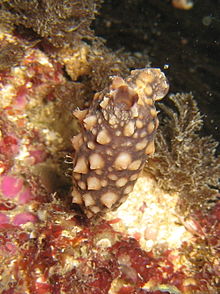- Styela clava
-
Styela clava Scientific classification Kingdom: Animalia Phylum: Chordata Subphylum: Tunicata Class: Ascidiacea Order: Stolidobranchia Family: Styelidae Genus: Styela Species: S. clava Binomial name Styela clava[1]
Herdman, 1881The Stalked Sea Squirt, Styela clava, is a solitary, hermaphroditic, ascidian tunicate that is found off Australia[2] and New Zealand,[3] both coasts of North America,[4] and Europe.[5]
These sea squirts are characterized by their brown or yellow, rough and wrinkled surface. They can grow to be about 6 in (15 cm) tall and can be found on lobster pots, pilings, and fishing nets. This species of sea squirts is native to Japan. It may have been carried to New England waters from Europe (where it arrived in the early 1950s) in ballast water or ship fouling.[6]
It is also commonly eaten in Korea, where it is eaten in soup, and is called Mideodeok (미더덕). When the animal is hammered to prepare it as food, it is believed that inhaling some of its tissue can cause asthma. (Body extracts are highly allergenic, but mideodeok preparation often occurs under poorly ventilated working conditions).[citation needed]
Contents
Other names
- Club or Clubbed Tunicate
- Solitary Sea Squirt
- Rough Sea Squirt
- Leathery Sea Squirt
- Asian Sea Squirt
Behavior
Populations around Los Angeles, CA grow 1-1.5 cm/month for 6 months, reaching maturity and slowing growth at about 9 cm in size. Broadcast spawning occurs late spring to early fall. They occur to at least 25 m deep, and filter approximately 150 mL of water / minute / gram body weight.[7]
External links
- National Introduced Marine Pest Information System of Australia: Leathery Sea Squirt
- Narragansett Bay Biota Gallery: Asian Stalked Sea Squirt
- National Centre for Aquatic Biodiversity & Biosecurity of New Zealand: Invasive Sea Squirt Fact Sheet
- The Tunicate Styela: A Community Housing Project
- Species Profile- Clubbed Tunicate (Styela clava), National Invasive Species Information Center, United States National Agricultural Library. Lists general information and resources for Clubbed Tunicate.
Notes
- ^ "Styela clava". Integrated Taxonomic Information System. http://www.itis.gov/servlet/SingleRpt/SingleRpt?search_topic=TSN&search_value=159337. Retrieved February 17, 2007.
- ^ Hewitt, C., et al. (1999). "Marine biological invasions of Port Phillip Bay, Victoria.". Centre for Research on Introduced Marine Pests CSIRO Technical Report (20): 344.
- ^ Davis MH and Davis ME (2006). "Styela clava (Tunicata: Ascidacea) a new edition to the fauna of New Zealand.". Porcupine Marine Natural History Society Newsletter 20: 23–28.
- ^ Wonham MJ and Carlton JT (2005). "Trends in marine biological invasions at local and regional scales: the Northeast Pacific Ocean as a model system.". Biological Invasions 7 (3): 369–392. doi:10.1007/s10530-004-2581-7.
- ^ Davis MH and Davis ME (2005). "Styela clava (Tunicata: Ascidacea) a new edition to the fauna of the Portuguese coast". Journal of the Marine Biological Association of the United Kingdom 85 (2): 403–404. doi:10.1017/S002531540501132Xh.
- ^ "Asian Stalked Sea Squirt". Narragansett Bay Commission. Archived from the original on 2007-01-26. http://web.archive.org/web/20070126001851/http://omp.gso.uri.edu/doee/biota/inverts/tuni/as.htm. Retrieved 2007-02-18.
- ^ RH Morris, DP Abbott & EC Haderlie. 1980. Intertidal Invertebrates of California. Stanford University Press: Stanford, CA. p. 207-208.

This chordate-related article is a stub. You can help Wikipedia by expanding it.

